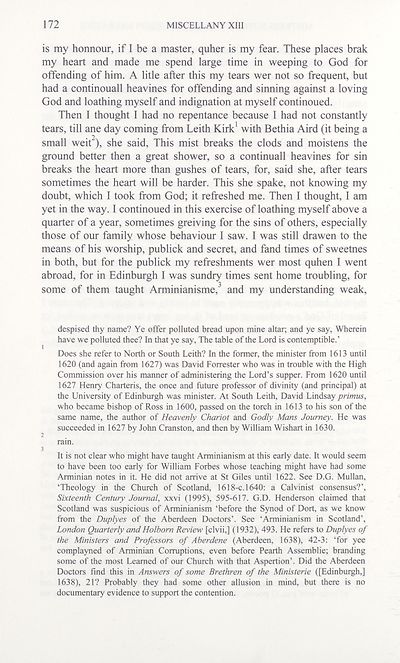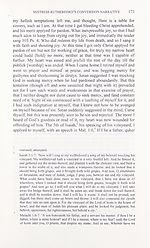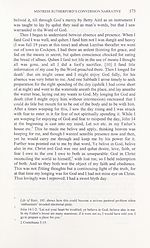Series 5 > Miscellany [of the Scottish History Society] XIII
(187) Page 172
Download files
Complete book:
Individual page:
Thumbnail gallery: Grid view | List view

172
MISCELLANY XIII
is my honnour, if I be a master, quher is my fear. These places brak
my heart and made me spend large time in weeping to God for
offending of him. A litle after this my tears wer not so frequent, but
had a continouall heavines for offending and sinning against a loving
God and loathing myself and indignation at myself continoued.
Then I thought I had no repentance because I had not constantly
tears, till ane day coming from Leith Kirk1 with Bethia Aird (it being a
small weit2), she said. This mist breaks the clods and moistens the
ground better then a great shower, so a continuall heavines for sin
breaks the heart more than gushes of tears, for, said she, after tears
sometimes the heart will be harder. This she spake, not knowing my
doubt, which I took from God; it refreshed me. Then I thought, I am
yet in the way. I continoued in this exercise of loathing myself above a
quarter of a year, sometimes greiving for the sins of others, especially
those of our family whose behaviour I saw. I was still drawen to the
means of his worship, publick and secret, and fand times of sweetnes
in both, but for the publick my refreshments wer most quhen I went
abroad, for in Edinburgh I was sundry times sent home troubling, for
some of them taught Arminianisme,3 and my understanding weak,
despised thy name? Ye offer polluted bread upon mine altar; and ye say. Wherein
have we polluted thee? In that ye say, The table of the Lord is contemptible.’
Does she refer to North or South Leith? In the former, the minister from 1613 until
1620 (and again from 1627) was David Forrester who was in trouble with the High
Commission over his manner of administering the Lord’s supper. From 1620 until
1627 Henry Charteris, the once and future professor of divinity (and principal) at
the University of Edinburgh was minister. At South Leith, David Lindsay primus,
who became bishop of Ross in 1600, passed on the torch in 1613 to his son of the
same name, the author of Heavenly Chariot and Godly Mans Journey. He was
succeeded in 1627 by John Cranston, and then by William Wishart in 1630.
It is not clear who might have taught Arminianism at this early date. It would seem
to have been too early for William Forbes whose teaching might have had some
Arminian notes in it. He did not arrive at St Giles until 1622. See D.G. Mullan,
‘Theology in the Church of Scotland, 1618-C.1640: a Calvinist consensus?’,
Sixteenth Century Journal, xxvi (1995), 595-617. G.D. Henderson claimed that
Scotland was suspicious of Arminianism ‘before the Synod of Doit, as we know
from the Duplyes of the Aberdeen Doctors’. See ‘Arminianism in Scotland’,
London Quarterly and Holbom Review [clvii,] (1932), 493. He refers to Duplyes of
the Ministers and Professors of Aberdene (Aberdeen, 1638), 42-3: ‘for yee
complayned of Arminian Corruptions, even before Pearth Assemblie; branding
some of the most Learned of our Church with that Aspertion’. Did the Aberdeen
Doctors find this in Answers of some Brethren of the Ministerie ([Edinburgh,]
1638), 21? Probably they had some other allusion in mind, but there is no
documentary evidence to support the contention.
MISCELLANY XIII
is my honnour, if I be a master, quher is my fear. These places brak
my heart and made me spend large time in weeping to God for
offending of him. A litle after this my tears wer not so frequent, but
had a continouall heavines for offending and sinning against a loving
God and loathing myself and indignation at myself continoued.
Then I thought I had no repentance because I had not constantly
tears, till ane day coming from Leith Kirk1 with Bethia Aird (it being a
small weit2), she said. This mist breaks the clods and moistens the
ground better then a great shower, so a continuall heavines for sin
breaks the heart more than gushes of tears, for, said she, after tears
sometimes the heart will be harder. This she spake, not knowing my
doubt, which I took from God; it refreshed me. Then I thought, I am
yet in the way. I continoued in this exercise of loathing myself above a
quarter of a year, sometimes greiving for the sins of others, especially
those of our family whose behaviour I saw. I was still drawen to the
means of his worship, publick and secret, and fand times of sweetnes
in both, but for the publick my refreshments wer most quhen I went
abroad, for in Edinburgh I was sundry times sent home troubling, for
some of them taught Arminianisme,3 and my understanding weak,
despised thy name? Ye offer polluted bread upon mine altar; and ye say. Wherein
have we polluted thee? In that ye say, The table of the Lord is contemptible.’
Does she refer to North or South Leith? In the former, the minister from 1613 until
1620 (and again from 1627) was David Forrester who was in trouble with the High
Commission over his manner of administering the Lord’s supper. From 1620 until
1627 Henry Charteris, the once and future professor of divinity (and principal) at
the University of Edinburgh was minister. At South Leith, David Lindsay primus,
who became bishop of Ross in 1600, passed on the torch in 1613 to his son of the
same name, the author of Heavenly Chariot and Godly Mans Journey. He was
succeeded in 1627 by John Cranston, and then by William Wishart in 1630.
It is not clear who might have taught Arminianism at this early date. It would seem
to have been too early for William Forbes whose teaching might have had some
Arminian notes in it. He did not arrive at St Giles until 1622. See D.G. Mullan,
‘Theology in the Church of Scotland, 1618-C.1640: a Calvinist consensus?’,
Sixteenth Century Journal, xxvi (1995), 595-617. G.D. Henderson claimed that
Scotland was suspicious of Arminianism ‘before the Synod of Doit, as we know
from the Duplyes of the Aberdeen Doctors’. See ‘Arminianism in Scotland’,
London Quarterly and Holbom Review [clvii,] (1932), 493. He refers to Duplyes of
the Ministers and Professors of Aberdene (Aberdeen, 1638), 42-3: ‘for yee
complayned of Arminian Corruptions, even before Pearth Assemblie; branding
some of the most Learned of our Church with that Aspertion’. Did the Aberdeen
Doctors find this in Answers of some Brethren of the Ministerie ([Edinburgh,]
1638), 21? Probably they had some other allusion in mind, but there is no
documentary evidence to support the contention.
Set display mode to:
![]() Universal Viewer |
Universal Viewer | ![]() Mirador |
Large image | Transcription
Mirador |
Large image | Transcription
Images and transcriptions on this page, including medium image downloads, may be used under the Creative Commons Attribution 4.0 International Licence unless otherwise stated. ![]()
| Scottish History Society volumes > Series 5 > Miscellany [of the Scottish History Society] XIII > (187) Page 172 |
|---|
| Permanent URL | https://digital.nls.uk/127315773 |
|---|
| Description | Over 180 volumes, published by the Scottish History Society, containing original sources on Scotland's history and people. With a wide range of subjects, the books collectively cover all periods from the 12th to 20th centuries, and reflect changing trends in Scottish history. Sources are accompanied by scholarly interpretation, references and bibliographies. Volumes are usually published annually, and more digitised volumes will be added as they become available. |
|---|


